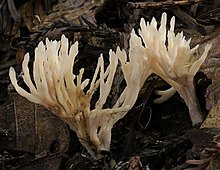
The Russulales are an order of the Agaricomycetes,. According to the Dictionary of the Fungi, the order consists of 12 families, 80 genera, and 1767 species. According to Species Fungorum, the order contains 13 families, 117 genera, and 3,060 species.
Hymenomycetes was formerly the largest taxonomic group of fungi within the division Basidiomycota, but the term is no longer taxonomically relevant. Many familiar fungi belong to this class, including bracket fungi and toadstools. This class contained the orders Agaricales, Boletales, and Russulales.
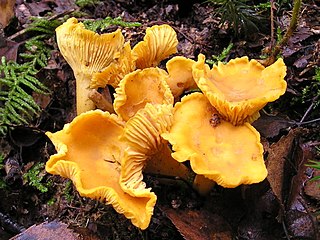
The Cantharellales are an order of fungi in the class Agaricomycetes. The order includes not only the chanterelles (Cantharellaceae), but also some of the tooth fungi (Hydnaceae), clavarioid fungi, and corticioid fungi (Botryobasidiaceae). Species within the order are variously ectomycorrhizal, saprotrophic, associated with orchids, or facultative plant pathogens. Those of economic importance include edible and commercially collected Cantharellus, Craterellus, and Hydnum species as well as crop pathogens in the genera Ceratobasidium and Thanatephorus (Rhizoctonia).
Heterobasidiomycetes, including jelly fungi, smuts and rusts, are basidiomycetes with septate basidia. This contrasts them to homobasidiomycetes, including most mushrooms and other Agaricomycetes, which have aseptate basidia. The division of all basidiomycetes between these two groups has been influential in fungal taxonomy, and is still used informally, but it is no longer the basis of formal classification. In modern taxonomy homobasidiomycetes roughly correspond to the monophyletic class Agaricomycetes, whereas heterobasidiomycetes are paraphyletic and as such correspond to various taxa from different taxonomic ranks, including the Basidiomycota other than Agaricomycetes and a few basal groups within Agaricomycetes.

The Hymenochaetales are an order of fungi in the class Agaricomycetes. The order in its current sense is based on molecular research and not on any unifying morphological characteristics. According to one 2008 estimate, the Hymenochaetales contain around 600 species worldwide, mostly corticioid fungi and poroid fungi, but also including several clavarioid fungi and agarics. Species of economic importance include wood decay fungi in the genera Phellinus and Inonotus sensu lato, some of which may cause losses in forestry. Therapeutic properties are claimed for Inonotus obliquus ("chaga") and Phellinus linteus, both of which are now commercially marketed.
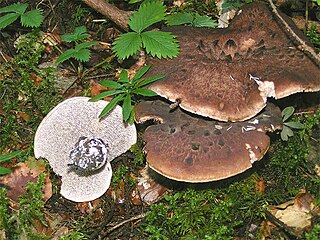
The Thelephorales are an order of fungi in the class Agaricomycetes. The order includes corticioid and hydnoid fungi, together with a few polypores and clavarioid species. Most fungi within the Thelephorales are ectomycorrhizal. None is of any great economic importance, though Sarcodon imbricatus is edible and commercially marketed, whilst several species have been used for craft dyeing.

The Agaricomycetes are a class of fungi in the division Basidiomycota. The taxon is roughly identical to that defined for the Homobasidiomycetes by Hibbett & Thorn, with the inclusion of Auriculariales and Sebacinales. It includes not only mushroom-forming fungi, but also most species placed in the deprecated taxa Gasteromycetes and Homobasidiomycetes. Within the subdivision Agaricomycotina, which already excludes the smut and rust fungi, the Agaricomycetes can be further defined by the exclusion of the classes Tremellomycetes and Dacrymycetes, which are generally considered to be jelly fungi. However, a few former "jelly fungi", such as Auricularia, are classified in the Agaricomycetes. According to a 2008 estimate, Agaricomycetes include 17 orders, 100 families, 1147 genera, and about 21000 species. Modern molecular phylogenetic analyses have been since used to help define several new orders in the Agaricomycetes: Amylocorticiales, Jaapiales, Stereopsidales, and Lepidostromatales.
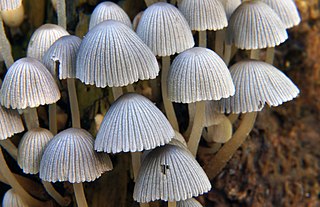
Agaricomycotina is one of three subdivisions of the Basidiomycota, and represents all of the fungi which form macroscopic fruiting bodies. Agaricomycotina contains over 30,000 species, divided into three classes: Tremellomycetes, Dacrymycetes, and Agaricomycetes. Around 98% of the species are in the class Agaricomycetes, including all the agarics, bracket fungi, clavarioid fungi, corticioid fungi, and gasteroid fungi. Tremellomycetes contains many basidiomycete yeasts and some conspicuous jelly fungi. Dacrymycetes contains a further group of jelly fungi. These taxa are founded on molecular research, based on cladistic analysis of DNA sequences, and supersede earlier morphology-based classifications. Agaricomycotina contains nearly one third of all described species of fungi.

The Gomphales are an order of basidiomycete fungi. Some or all families belonging to Gomphales have been sometimes included in the order Phallales, the now-obsolete Ramariaceae was also previously included in Cantharellales. Recent phylogenetic analyses include in Gomphales the families of the original description of the order by Walter Jülich, with addition of Clavariadelphaceae. According to one 2008 estimate, the Gomphales contain 18 genera and 336 species.

The Hysterangiales are an order of fungi in the class Agaricomycetes, subclass Phallomycetidae. According to one 2008 estimate, the order contains five families, 18 genera, and 114 species.

The Hydnodontaceae are a family of fungi in the class Agaricomycetes. According to a 2008 estimate, the family contains 15 genera and 105 species. It is the only family in the order Trechisporales.

The Corticiales are an order of fungi in the class Agaricomycetes. The order is composed of corticioid fungi. Species within the order are generally saprotrophic, most of them wood-rotters, but several are parasitic on grasses or lichens. Plant pathogens of economic importance include Erythricium salmonicolor, Laetisaria fuciformis, Waitea circinata, Waitea oryzae, and Waitea zeae.

The Auriculariales are an order of fungi in the class Agaricomycetes. Species within the order were formerly referred to the "heterobasidiomycetes" or "jelly fungi", since many have gelatinous basidiocarps that produce spores on septate basidia. Around 200 species are known worldwide, placed in six or more families, though the status of these families is currently uncertain. All species in the Auriculariales are believed to be saprotrophic, most growing on dead wood. Fruit bodies of several Auricularia species are cultivated for food on a commercial scale, especially in China.
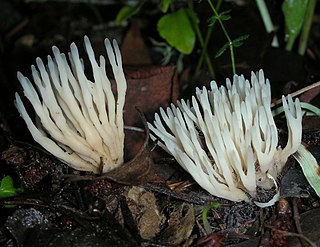
The Tremellodendropsidaceae are a family of fungi in the class Agaricomycetes. The family currently comprises a single genus containing a small group of clavarioid fungi with partly septate basidia.

The Serpulaceae are a family of fungi in the Boletales order. According to the Dictionary of the Fungi, the family contains 4 genera and 20 species. However, a molecular phylogenetics study showed that the genus Neopaxillus, which was formerly placed in this family, belongs in the family Crepidotaceae in the order Agaricales.

Tremellodendropsis is a genus of clavarioid fungi in the family Tremellodendropsidaceae. Species are distinguished microscopically by having partly septate basidia, a feature that led to their former placement within the Auriculariales or Tremellales. Molecular research, based on cladistic analysis of DNA sequences, has, however, shown that they form a distinct group within the Agaricomycetes.

Lepidostromatales is an order of fungi in the class Agaricomycetes. It is the only known order of basidiomycete fungi composed entirely of lichenized members. Morphologically, the fruiting bodies of all species are clavarioid. Six species are known, five of which were described within the span of 2007–2013. Due to its morphological similarity to the genus Multiclavula, its isolated phylogenetic position was not understood until quite recently. The photobionts that have been found in association with members of this group are not known to associate with any other types of lichenized fungi.

Lepidostroma is a genus in the family Lepidostromataceae. The genus is distinguished from all other lichenized clavarioid fungi by having a distinctly squamulose thallus with scattered to dense rounded to reniform squamules. Four species are known from the tropics of Africa and the Americas.
The Stereopsidales are an order of fungi in the class Agaricomycetes. It was first described in 2014 to contain the genera Stereopsis, which was until then classified in the order Polyporales, and Clavulicium, which was until then classified in the order Cantharellales. Molecular phylogenetics analysis showed these two genera to belong together in their own order. This order might belong in the subclass Phallomycetidae, but this relationship was poorly supported. The Stereopsidales contain corticoid fungi and stalked, funnel shaped fungi (Stereopsis). They are united by features of their spores, which have refractive contents, and become angular and amber-like as they dry. All known members also possess basidia with two sterigmata, although this is also a feature of fungi in many other orders.
Anixia is a genus of fungi that belongs to the Agaricomycetes class; it is not assigned to an order or a family. The Anixia genus consists of twelve fungi species. The genus was first documented in 1819 by Swedish mycologist Elias Magnus Fries.
